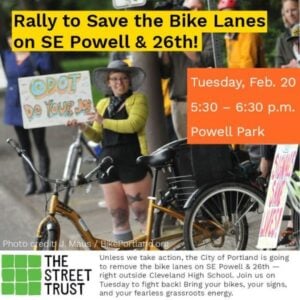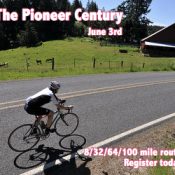
– download PDF –
The Oregon Department of Transportation is so convinced that the bike lanes on Southeast 26th Avenue are dangerous for bicycle riders that they’ve ordered the City of Portland to remove them as soon as possible.
Inexplicably, and despite evidence showing the bike lanes (even at a paltry three-feet wide) make the street safer, ODOT has cited no evidence or best practice standards for their decision. The only rationale offered so far is a concern that the intersection of 26th and Powell is too dangerous for bike riders and a new crossing two blocks east is much safer.
Everyone agrees the new signal and median at SE 28th (part of the new 20s Bikeway) is indeed much safer. But it’s up a hill and two blocks away. And since when is a safer crossing on one street, reason for the removal of bike infrastructure from another?
“ODOT’s reasons are a mystery to us,” a Portland Bureau of Transportation staffer told me recently.
Now there’s a new (to us) piece to the puzzle: A “road safety audit” report prepared for ODOT by Kittelson & Associates, Inc. in 2014. The audit (PDF) focused specifically on Powell between 20th and 33rd Avenue — a section with a crash rate over twice as high as the statewide average for similar roads. The stated purpose of the audit was to, “identify potential issues contributing to crashes and suggest treatments for addressing those issues.”
26th Avenue was one of the intersections that the team of engineers and planners analyzed. Of the 10 specific intersections assessed in the audit, 26th was one of five placed in “Category III”. That’s the highest of the three categories for issues defined as having, “potentially the greatest risk compared to the other observed issues; they are associated with higher exposure, probability, and/or consequence than other issues.”
Advertisement
The audit makes is clear that the Powell and 26th intersection needs help. And it’s especially dangerous for bicycle riders. According to the audit, there were five reported crashes involving a bicycle rider in this section of 26th between 2008 and 2013 — and four of them happened at 26th. “The majority of bike crashes involved bicyclists traveling through the intersection (north or south) and a vehicle making a turning movement,” states the audit.
Of the many recommendations, the report urged ODOT to improve safety at 26th by addressing vehicle turning movements. They suggested prohibiting right turns on red, adjusting signal timing so that drivers don’t get impatient, and they even recommended the use of “leading pedestrian intervals” (LPIs, where the “walk” signal comes on before the main signal turns green). The audit also recommended an “expanded pedestrian landing area” on all the corners to “discourage pedestrians (e.g., students at Cleveland High School) from standing in the roadway.”
When it came to the now infamous bike lanes on 26th, the audit recommended either tearing them out or — surprisingly — widening them.

As part of “system-wide suggestions for lack of protection for bike crossings,” the audit recommended, “installing bike lanes on cross-streets heavily traveled by bicyclists (21st Avenue, 26th Avenue (wider)…”
Here’s more:
“Consider the following two options to accommodate bikes crossing Powell Boulevard: Widen both sides by removing the landscape strip and moving the bus stop to accommodate wider bike lanes on both sides.”
Of course, the audit also recommended removing the bike lanes and replacing them with a new crossing further east on Powell. The latter part of that recommendation has occurred. Thankfully, the former hasn’t. At least not yet.
When asked to comment on Kittelson’s recommendation to widen the bike lanes, ODOT spokesperson Don Hamilton told me today that, “Nothing has changed since our previous conversations.”
As for the removal of the bike lanes? “Additional conversations are under way,” he said.
Hamilton’s reply jibes with what I’ve heard from another source close to the “additional conversations.” I’ll share more when I hear it, but for now it appears that the bike lanes just might survive. Whether or not they’ll ever be widened however, remains to be seen.
For a comprehensive look at how Powell is dangerous by design, check out the audit for yourself.
— Jonathan Maus: (503) 706-8804, @jonathan_maus on Twitter and jonathan@bikeportland.org
Never miss a story. Sign-up for the daily BP Headlines email.
BikePortland needs your support.







I’ve ridden SE 26th between Powell and Clinton numerous times, observing the properties on both sides, and there is no reason we can’t widen the bike lanes on the street by removing the existing northbound on-street parking strip:
– Every property on the stretch has a long driveway or garage (or most commonly, both)
– The street grid is complete through here, so visitors and deliveries can park around the corner and never have to walk more than ~100ft (since the blocks are 200ft long)
– The parking strip is only lightly used, except in the block south of Clinton (where the bike lane drops off), to the degree that when traveling northbound, I usually ride in the parking lane and only use the bike lane to “pass” the occasional parked vehicle
This is definitely a situation where the city needs to put its foot down, invoke the transportation hierarchy, and restripe the street for two buffered bike lanes and no on-street parking.
using Google Maps I can see that everybody on that stretch has their own private parking on their property so they wouldn’t be put out too much by having the parking removed from the street for a buffered bike lane…
Nice research, JM.
A great look inside the sordid world of ODOT. Thanks for finding out about this.
Don Hamilton: always ready for an in-depth conversation.
Thanks for keeping this vulnerable roadway user / traffic safety topic front and center.
tearing out the planting strips for more road shouldn’t be an option, even if it’s to widen bike lanes… there is already plenty of road for what we need…
they can simply remove the 26th center turn lane and create a separate signal phase for each north/south direction… this leaves room to buffer the bike lane…
Could you elaborate more on this proposal, Spiffy? Specifically, would there be a left turn signal or would left turns be permitted without said center lane? Thank you.
It’s called split-phase. East-west operates as it does today, but North-South would change to North through, right and left, then South, through, right and left. It typically adds delay to the East-West movements. Greeley at Rosa Parks has a N-S split phase.
This is my most-crossed “major” intersection. The three biggest problems I’ve had with it over the years are:
1) Cars making a left turn through the intersection
2) Parents parking their cars in the bike lane in front of the school
3) That giant puddle that always forms on the NE corner.
“1” was fixed when they put in the left turn signal.
“2” has diminished a lot (almost completely) in the last year or so. Someone must have sent a memo to the parents to stop it.
“3” is still a problem and my feet get wet all the time if I don’t want to steer into traffic.
I guess what I’m saying is: This is the safest the intersection has ever been and I feel completely secure and comfortable going through it. Whomever is making this decision is working with extremely inaccurate information.
I’m grateful that you haven’t had any issues there. That said, comfortability of a competent person on a bicycle is not the standard we should be aiming for- we should be trying to make it safe for _all_ roadway users.
I completely agree with you. Now that I’ve reread my comment, I want to make it clear that the change I’m against *isn’t* the widening of the bike lanes (I’m all for it!) but the removal of them, which is the current plan. I would be overjoyed if the bike lanes were wider.
Are there any lights in Portland where pedestrians get their own cycle to cross (thus allowing them to walk through the diagonal if they want)? Given the number of pedestrians before and after school, that would be an easy improvement to make it safer for them.
igor – RU asking about a “Pedestrian Scramble” / “Barnes Dance” intersection?
https://ddot.dc.gov/page/barnes-dance-intersections
https://ddot.dc.gov/sites/default/files/dc/sites/ddot/page_content/attachments/Barnes%20Dance%20FINAL-English%20front-Spanish%20Back.pdf
Yeah, this one: https://www.portlandoregon.gov/transportation/article/554928
just the one behind Powell’s main store that I know of…
https://goo.gl/maps/XKkG1pjus242
but there are several that let the pedestrian go first before any other mode (leading pedestrian interval, or LPI)…
LPI locations include:
N Williams at Killingsworth (heavy turns)
NW Glisan at 15th (I-405 on ramp)
We have exactly one, though that intersection also has an inexplicable signal cycle wherein NO pedestrian lights are illuminated even though traffic is only going two directions (aka no turn lights). It’s a bit poorly implemented.
That’s typical of the “Barnes Dance” intersections I’ve seen. Pedestrians are *only* given the option to walk during the “all-walk” phase of the cycle.
This does seem like a good candidate for such a treatment. Downside of the Barnes Dance is that
By the way, 2nd and Pike in Seattle is also a famous example of such an intersection. When I was in Banff, Alberta a couple years ago, I was surprised to see several of the intersections along their main drag use this treatment. And finally, in my own South Minneapolis neighborhood we have such an intersection (at Portland Avenue and Diamond Lake Road), although it’s poorly designed and lacks a crosswalk along one side.
Downside of the Barnes Dance is that it can dramatically increase the overall cycle length, for two reasons. First, you’re adding an extra phase that didn’t exist before (because typically, pedestrian movements are concurrent with parallel traffic). And second, the dedicated WALK interval needs to be basically 50% longer than the minimum WALK intervals along the sides of the intersection, to allow for the longer diagonal crossing distance. The first problem can be partly offset by reducing the minimum green interval for cars below the minimum WALK interval, but you’re still going to end up with a longer overall phase. This means not only cars, but also cyclists, will get longer reds and have to wait longer for their turn to cross the intersection.
Cars! Cars! Cars! That’s pretty much odot and now trimet in a nutshell. They both know that cars are the least efficient yet the most politically beneficial. So…they do what they do.
It would be bad enough if we weren’t also staring what is rapidly shaping up to be catastrophic climate change in the face.
This report came out before that cyclist lost his leg at this intersection, but they took no action until after that incident, and only due to increased public pressure for improvements.
ODOT knew.
N. W. 11th & Couch
Basically thus boils down to this:
What ODOT wants, ODOT gets.
And the people be damned.
The Union Pacific Railroad is the driving force for increased truck flow on 26th. ODOT is bowing to UPRR pressues.
I believe this is true. But 26th is a PBOT road, and I would hope they’d be a bit more progressive. Transportation hierarchy and all that…
As far as I can tell, the hierarchy is a nice theory that “talks softly but (doesn’t) carry a big stick.”
HK,
Neighborhood Collector
City Bikeway
City Walkway
Freight District Street
Major Emergency Response route
Transit Access
I meant the one that suggests bikes should not be put on an indirect, hilly, inferior route so that highly polluting short-haul commercial vehicles can have a more convenient shot from a poorly located rail yard to Powell through a residential neighborhood.